Response Pattern of Rainfall to the Efficiency and Threshold of Soil Water Recharge in Different Slopes
Abstract
1. Introduction
2. Materials and Methods
2.1. Outline of the Experiment Site
2.2. Experiment Design
2.2.1. Materials
2.2.2. Model Slope
2.2.3. Rainfall and SWC Monitoring
2.3. Data Analysis
2.3.1. Coefficient of Variation
2.3.2. Soil Water Storage
2.3.3. Soil Water Recharge Amount
2.3.4. Lag Time
2.3.5. Rainfall Replenishment Rate
2.3.6. Rainfall Replenishment Efficiency
3. Results and Analysis
3.1. Characteristics of Precipitation During Experiment
3.2. Spatiotemporal Distribution of Soil Water in Ecological Slopes
3.2.1. Temporal Variation of Soil Water Content
3.2.2. Spatial Distribution of Soil Water
3.3. Soil Water Recharge and Lag Time of Rainfall Events
3.3.1. Soil Water Recharge
3.3.2. Lag Time of Rainfall Events
3.4. Rainfall Replenishment Efficiency and the Threshold to Soil Water
3.4.1. Rainfall Replenishment Efficiency of Rainfall Events
3.4.2. Rainfall Threshold of Soil Water Recharge
4. Discussion
4.1. Effect of Rainfall on Soil Water Recharge
4.2. Effect of Ecological Restoration on Soil Water Recharge
4.3. Influential Actors of Rainfall Threshold for Soil Water Recharge
5. Conclusions
Author Contributions
Funding
Institutional Review Board Statement
Informed Consent Statement
Data Availability Statement
Conflicts of Interest
References
- Chen, Q.; Shen, J.; Ku, M.; Wang, L. Numerical Investigation of Submarine Spreading Landslide Failures. Geotech. Geol. Eng. 2025, 43, 42. [Google Scholar] [CrossRef]
- Yuliana, Y.; Kamchoom, V.; Munirwan, R.P.; Gunawan, H. A Review of Herbaceous Vegetation Effect on Mechanical Properties of Soil for Enhancing Slope Stability; IOP Publishing Ltd.: Bristol, UK, 2024. [Google Scholar]
- Zhou, X.; Hu, K.; Xiao, H.; Yang, Y.; Chen, J.; Cheng, Y. Effects of vegetation on the spatiotemporal distribution of soil water content in re-vegetated slopes using temporal stability analysis. Catena 2024, 234, 12. [Google Scholar] [CrossRef]
- Zhang, Y.; Yang, R.; Sun, M.; Lu, Y.; Zhang, L.; Yin, Y.; Li, X. Identification of spatial protection and restoration priorities for ecological security pattern in a rapidly urbanized region: A case study in the Chengdu–Chongqing economic Circle, China. J. Environ. Manag. 2024, 366, 12. [Google Scholar] [CrossRef] [PubMed]
- Ma, J.; Han, J.; Zhang, Y.; Dong, Q.; Du, Y. Temporal stability of soil water content on slope during the rainy season in gully regulation watershed. Environ. Earth Sci. 2020, 79, 173. [Google Scholar] [CrossRef]
- Ma, T.; Deng, X.; Chen, L.; Xiang, W. The soil properties and their effects on plant diversity in different degrees of rocky desertification. Sci. Total Environ. 2020, 736, 139667. [Google Scholar] [CrossRef]
- Tao, G.; Cheng, Y.; Xiao, H.L.; Huang, S.; Zhou, X. Experimental Study on the Influence of Substrate Properties on Rainfall Infiltration and Runoff from Ecological Slopes. Appl. Sci. 2023, 13, 5557. [Google Scholar] [CrossRef]
- Zurweller, B.A.; Rowland, D.L.; Tillman, B.L.; Payton, P.; Erickson, J.; Racette, K.; Carter, E. Soil water depletion of peanut subspecies as influenced by water-use traits and soil water availability. J. Agron. Crop Sci. 2021, 208, 928–940. [Google Scholar] [CrossRef]
- Hess, L.J.T.; Hinckley, E.L.S.; Robertson, G.P.; Hamilton, S.K.; Matson, P.A. Rainfall Intensification Enhances Deep Percolation and Soil Water Content in Tilled and No-Till Cropping Systems of the US Midwest. Vadose Zone J. 2018, 17, 1–12. [Google Scholar] [CrossRef]
- Ng, C.W.W.; Ni, J.J.; Leung, A.K. Effects of plant growth and spacing on soil hydrological changes: A field study. Geotechnique 2020, 70, 15. [Google Scholar] [CrossRef]
- He, Z.; Xiao, P.; Jia, G.; Liu, Z.; Yu, X. Field studies on the influence of rainfall intensity, vegetation cover and slope length on soil moisture infiltration on typical watersheds of the Loess Plateau, China. Hydrol. Process. 2020, 34, 4904–4919. [Google Scholar] [CrossRef]
- Zhu, P.; Zhang, G.; Wang, H.; Xing, S. Soil infiltration properties affected by typical plant communities on steep gully slopes on the Loess Plateau of China. J. Hydrol. 2020, 590, 125535. [Google Scholar] [CrossRef]
- Yu, B.; Liu, G.; Liu, Q.; Wang, X.; Feng, J.; Huang, C. Soil moisture variations at different topographic domains and land use types in the semi-arid Loess Plateau, China. Catena 2018, 165, 125–132. [Google Scholar] [CrossRef]
- Qin, C.; Wang, R.; Chen, W.; Shi, Y.; Sun, H.; Tang, J.; Wang, L. Stability of Ficus virens-Reinforced Slopes Considering Mechanical and/or Hydrological Effects. Forests 2024, 15, 133. [Google Scholar] [CrossRef]
- Feng, H.G.; Xiao, H.; Jishuang, G. Bond strength between concrete substrate and repair mortar: Effect of fibre stiffness and substrate surface roughness. Cem. Concr. Compos. 2020, 114, 103746. [Google Scholar] [CrossRef]
- Ferreiro-Dominguez, N.; Palma, J.H.N.; Paulo, J.A.; Rigueiro-Rodriguez, A.; Mosquera-Losada, M.R. Assessment of soil carbon storage in three land use types of a semi-arid ecosystem in South Portugal. Catena Interdiscip. J. Soil Sci. Hydrol. Geomorphol. Focus. Geoecol. Landsc. Evol. 2022, 213, 106196. [Google Scholar] [CrossRef]
- Mertens, J.; Germer, J.; Filho, J.C.d.A.; Sauerborn, J. Effect of biochar, clay substrate and manure application on water availability and tree-seedling performance in a sandy soil. Arch. Agron. Soil Sci. 2017, 63, 969–983. [Google Scholar] [CrossRef]
- Hallett, P.D.; Young, I.M. Changes to water repellence of soil aggregates caused by substrate-induced microbial activity. Eur. J. Soil Sci. 1999, 50, 35–40. [Google Scholar] [CrossRef]
- Wu, H.; Li, Z.; Song, W.; Bai, S. Effects of Superabsorbent Polymers on Moisture Migration and Accumulation Behaviors in Soil. J. Clean. Prod. 2020, 279, 123841. [Google Scholar] [CrossRef]
- Yang, L.; Zhang, H.; Chen, L. Identification on threshold and efficiency of rainfall replenishment to soil water in semi-arid loess hilly areas. Sci. China 2018, 61, 10. [Google Scholar] [CrossRef]
- Xue, F.; Hu, Y.N. Diverse Responses of Vegetation Greenness and Productivity to Land Use and Climate Change: A Comparison of Three Urban Agglomerations in China. Sustainability 2024, 16, 5900. [Google Scholar] [CrossRef]
- Shang, R.; Sun, F.; Lu, H.; Han, P.; Fu, J.; Liu, W. Impact Mechanism of Vegetation Slope Surface on the Runoff and Sediment Producing Procedure of Jinyang Ancient City in Different Periods. Environ. Eng. Manag. J. EEMJ 2024, 23, 1083–1095. [Google Scholar] [CrossRef]
- Sarris, D.; Christodoulakis, D. Topographic and climatic effects on Pinus halepensis s.l. growth at its drought tolerance margins under climatic change. J. For. Res. 2024, 35, 102. [Google Scholar] [CrossRef]
- Maris, L.; Petrolli, R.; Selosse, M.-A.; Legland, T.; Pache, G.; Griveau, C.; Torre, F.; Lopez-Pinot, D.; Marciau, R.; Bonnet, V. Impact of the local environmental factors associated to plant-fungi communities on the conservation of Liparis loeselii (L.) Rich. In the French Rhne-Alpes region. Acta Oecologica 2023, 120, 15. [Google Scholar] [CrossRef]
- Jiao, T.; Chang, G.; Zhou, X.; Yang, H.; Hou, Y.; Miao, X.; Liu, R.; Pu, X. Study on relationship between soil enzyme and soil fertility of alpine meadow in different carrying capacities. Acta Prataculturae Sin. 2009, 18, 98–104. [Google Scholar]
- Bai, Y.; Liu, M.; Yi, J.; Zhang, H. Temporal stability analysis of soil moisture along a coniferous forest hillslope with subtropical monsoon climate in southwest China. J. Mt. Sci. 2021, 18, 15. [Google Scholar] [CrossRef]
- Bialkowski, R.; Buttle, J.M. Stemflow and throughfall contributions to soil water recharge under trees with differing branch architectures. Hydrol. Process. 2015, 29, 4068–4082. [Google Scholar] [CrossRef]
- Kerkides, P. Implications of Hysteresis on the Horizontal Soil Water Redistribution after Infiltration. Water 2021, 13, 2773. [Google Scholar] [CrossRef]
- Singh, N.K.; Emanuel, R.E.; Mcglynn, B.L.; Miniat, C.F. Soil moisture responses to rainfall: Implications for runoff generation. Water Resour. Res. 2021, 57, e2020WR028827. [Google Scholar] [CrossRef]
- Liu, Z.; She, R.; Xiong, K.; Li, Y.; Cai, L. Effect of Vegetation Restoration on Soil Hydrology in Karst Area of Southwest China: Inspiration from Barrel Planting Experiments. Water 2021, 13, 1719. [Google Scholar] [CrossRef]
- Chen, H.; Shao, M.; Li, Y. The characteristics of soil water cycle and water balance on steep grassland under natural and simulated rainfall conditions in the Loess Plateau of China. J. Hydrol. 2008, 360, 242–251. [Google Scholar] [CrossRef]
- Li, Y.; Liu, Z.; Liu, G.; Xiong, K.; Cai, L. Dynamic variations in soil moisture in an epikarst fissure in the karst rocky desertification area. J. Hydrol. 2020, 591, 125587. [Google Scholar] [CrossRef]
- Xiaona, Y.; Yongmei, H.; Engui, L.; Xiaoyan, L.; Weihua, G. Effects of vegetation types on soil water dynamics during vegetation restoration in the Mu Us Sandy Land, northwestern China. J. Arid Land 2017, 9, 12. [Google Scholar]
- Li, B.; Rodell, M. Spatial variability and its scale dependency of observed and modeled soil moisture over different climate regions. Hydrol. Earth Syst. Sci. 2013, 17, 1177–1188. [Google Scholar] [CrossRef]
- He, Z.; Zhao, W.; Liu, H.; Chang, X. The response of soil moisture to rainfall event size in subalpine grassland and meadows in a semi-arid mountain range: A case study in northwestern China’s Qilian Mountains. J. Hydrol. 2012, 420–421, 183–190. [Google Scholar] [CrossRef]
- Petrie, M.D.; Collins, S.L.; Litvak, M.E. The ecological role of small rainfall events in a desert grassland. Ecohydrology 2015, 8, 1614–1622. [Google Scholar] [CrossRef]
- Mei, X.; Ma, L. Effect of afforestation on soil water dynamics and water uptake under different rainfall types on the Loess hillslope. Catena 2022, 213, 106216. [Google Scholar] [CrossRef]
- Nyawade, S.O.; Karanja, N.N.; Gachene, C.K.K.; Elmar, S.G.; Monica, P. Effect of potato hilling on soil temperature, soil moisture distribution and sediment yield on a sloping terrain. Soil Tillage Res. 2018, 184, 24–36. [Google Scholar] [CrossRef]
- Panpan, L.I.; Bing, W.; Yanfen, Y.; Guobin, L. Effects of vegetation near-soil-surface factors on runoff and sediment reduction in typical grasslands on the Loess Plateau, China. J. Arid Land 2022, 14, 325–340. [Google Scholar]
- Sun, C.; Hou, H.; Chen, W. Effects of vegetation cover and slope on soil erosion in the Eastern Chinese Loess Plateau under different rainfall regimes. PeerJ 2021, 9, e11226. [Google Scholar] [CrossRef]
- Chen, S.; Xie, Q.; Su, S.; Wu, L.; Zhong, S.; Zhang, Z.; Ma, C.; Qi, Y.; Hu, W.; Deng, J.; et al. Source and formation process impact the chemodiversity of rainwater dissolved organic matter along the Yangtze River Basin in summer. Water Res. 2021, 211, 118024. [Google Scholar] [CrossRef]
- Fu, S.; Wu, J.; Zhang, Q.; Xie, B. Robust and efficient synchronization for structural health monitoring data with arbitrary time lags. Eng. Struct. 2025, 322 Pt B, 119183. [Google Scholar] [CrossRef]
- Stern, E.; Riva, F.; Nielsen, S. Effects of Narrow Linear Disturbances on Light and Wind Patterns in Fragmented Boreal Forests in Northeastern Alberta. Forests 2018, 9, 486. [Google Scholar] [CrossRef]
- Ziemińska, K.; Bibbo, S.; Farrar, S.; Thompson, J.; Uriarte, M.; Ziaco, E.; Zimmerman, J.K.; Muscarella, R. Shifts in wood anatomical traits after a major hurricane. Funct. Ecol. 2023, 37, 3000–3014. [Google Scholar] [CrossRef]
- Timlin, D.J.; Heathman, G.C.; Ahuja, L.R. Solute Leaching in Crop Row vs. Interrow Zones. Soil Sci. Soc. Am. J. 1992, 56, 384–392. [Google Scholar] [CrossRef]
- Cowie, B.E.; Porley, V.; Robertson, N. Solar Disinfection (SODIS) Provides a Much Underexploited Opportunity for Researchers in Photocatalytic Water Treatment (PWT). ACS Catal. 2020, 10, 11779–11782. [Google Scholar] [CrossRef]
- Hui, X.; Zheng, Y.; Yan, H. Water distributions of low-pressure sprinklers as affected by the maize canopy under a centre pivot irrigation system. Agric. Water Manag. 2021, 245, 106646. [Google Scholar] [CrossRef]
- Srivastava, A.; Saco, P.M.; Rodriguez, J.F.; Kumari, N.; Chun, K.P.; Yetemen, O. The Role of Landscape Morphology on Soil Moisture Variability in Semi-arid Ecosystems. Hydrol. Process. 2020, 35, 13990. [Google Scholar] [CrossRef]
- Hou, G.; Bi, H.; Wei, X.; Kong, L.; Wang, N.; Zhou, Q. Response of Soil Moisture to Single-Rainfall Events under Three Vegetation Types in the Gully Region of the Loess Plateau. Sustainability 2018, 10, 3793. [Google Scholar] [CrossRef]
- Sharma, R.K. Laboratory study on stabilization of clayey soil with cement kiln dust and fiber. Geotech. Geol. Eng. 2017, 35, 2291–2302. [Google Scholar] [CrossRef]
- Ji, Y.; Shi, Z.; Yang, S.; Tian, S.; Yang, Q.; Chen, Y.; Shan, L.; Chen, Y.; Liu, J.; Yu, K. Effect of spatial differentiation of Pinus massoniana canopy branches and leaves on rainfall interception—An example from Changting County. Hydrol. Sci. J. 2024, 69, 15. [Google Scholar] [CrossRef]
- Parré, F.M.; Loiola, P.P.; Ballarin, C.S.; Monquero, P.A. Impact of invasive plant management on soil activity and litter decomposition in a tropical forest restoration. Restor. Ecol. 2023, 31, 13906. [Google Scholar] [CrossRef]
- Zhu, P.; Zhang, G.; Zhang, B.J.; Wang, H. Variation in soil surface roughness under different land uses in a small watershed on the Loess Plateau, China. Catena 2020, 188, 104465. [Google Scholar] [CrossRef]
- Wu, G.L.; Jia, C.; Huang, Z.; Lopez-Vicente, M.; Liu, Y. Plant litter crust appear as a promising measure to combat desertification in sandy land ecosystem. Catena 2021, 206, 105573. [Google Scholar] [CrossRef]
- Yi, F.; Deng, Y.; Li, Y. Responses of plant sap flow rate to epikarst water availability under different karst water-bearing media. J. Hydrol. 2023, 626 Pt B, 130373. [Google Scholar] [CrossRef]
- Guo, H.; Zhang, Q.; Chen, Y.; Lu, H. Effects of biochar on plant growth and hydro-chemical properties of recycled concrete aggregate. Sci. Total Environ. 2023, 882, 163557. [Google Scholar] [CrossRef] [PubMed]
- Li, J. Modeling the Stormwater Benefits of Green Roofs in the City of Toronto. J. Water Manag. Model. 2008, 16, 283–294. [Google Scholar] [CrossRef]
- Killham, K.; Amato, M.; Ladd, J.N. Effect of substrate location in soil and soil pore-water regime on carbon turnover. Soil Biol. Biochem. 1993, 25, 57–62. [Google Scholar] [CrossRef]
- Li, J.; Wang, X.; Jia, H.; Liu, Y.; Zhao, Y.; Shi, C.; Zhang, F.; Wang, K. Assessing the soil moisture effects of planted vegetation on slope stability in shallow landslide-prone areas. J. Soils Sediments 2021, 21, 2551–2565. [Google Scholar] [CrossRef]
- Jiang, X.J.; Liu, W.J.; Chen, C.F.; Yuan, J.Q.; Jin, Z.Q. Effects of three morphometric features of roots on soil water flow behavior in three sites in China. Geoderma 2018, 320, 161–171. [Google Scholar] [CrossRef]
- Feifel, M.; Durner, W.; Hohenbrink, T.L.; Peters, A. Effects of improved water retention by increased soil organic matter on the water balance of arable soils: A numerical analysis. Vadose Zone J. 2024, 23, e20302. [Google Scholar] [CrossRef]
- Vogelmann, E.S.; Reichert, J.M.; Prevedello, J.; Awe, G.O.; Cerdà, A. Soil moisture influences sorptivity and water repellency of topsoil aggregates in native grasslands. Geofis. Int. 2017, 305, 374–381. [Google Scholar] [CrossRef]
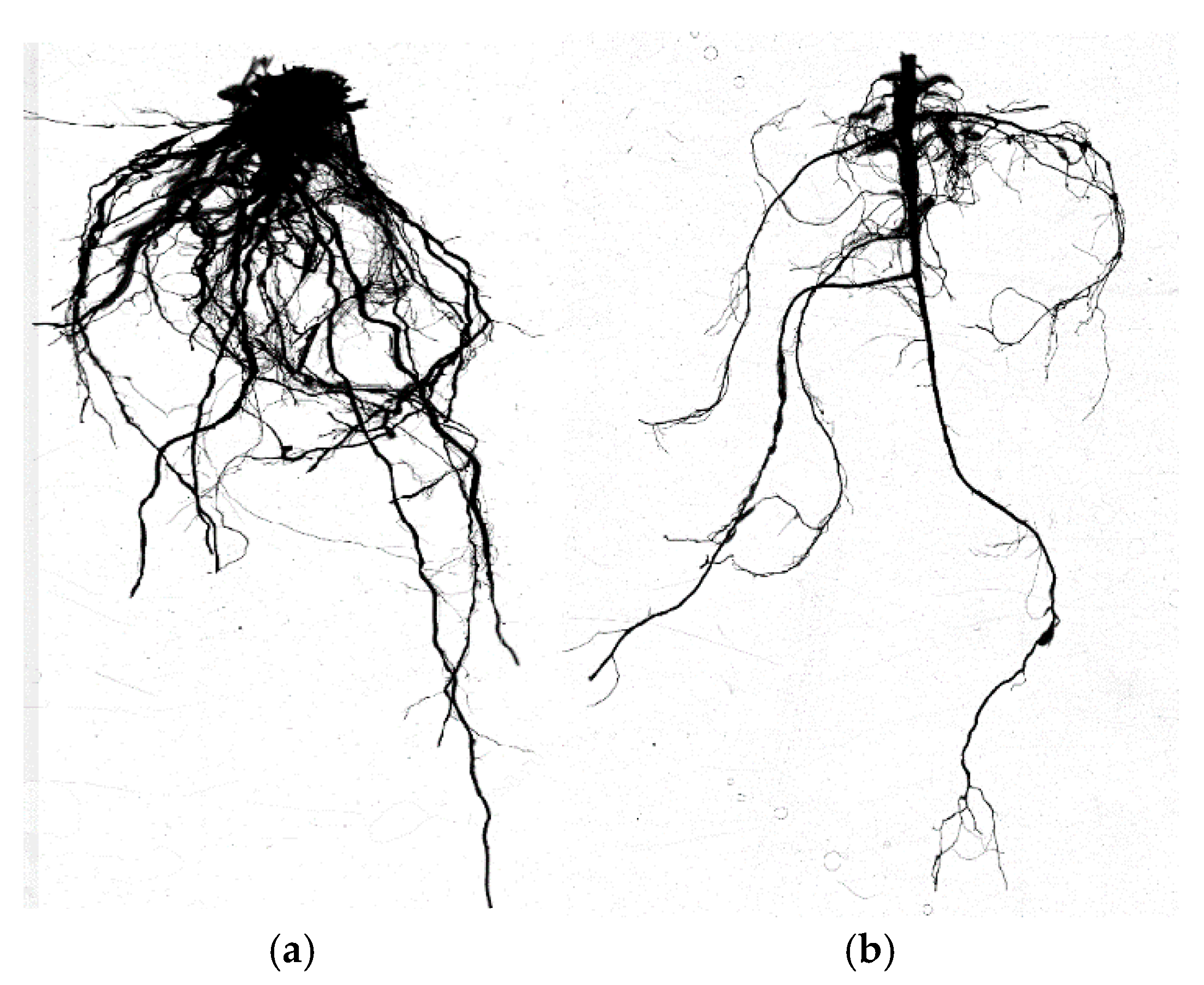
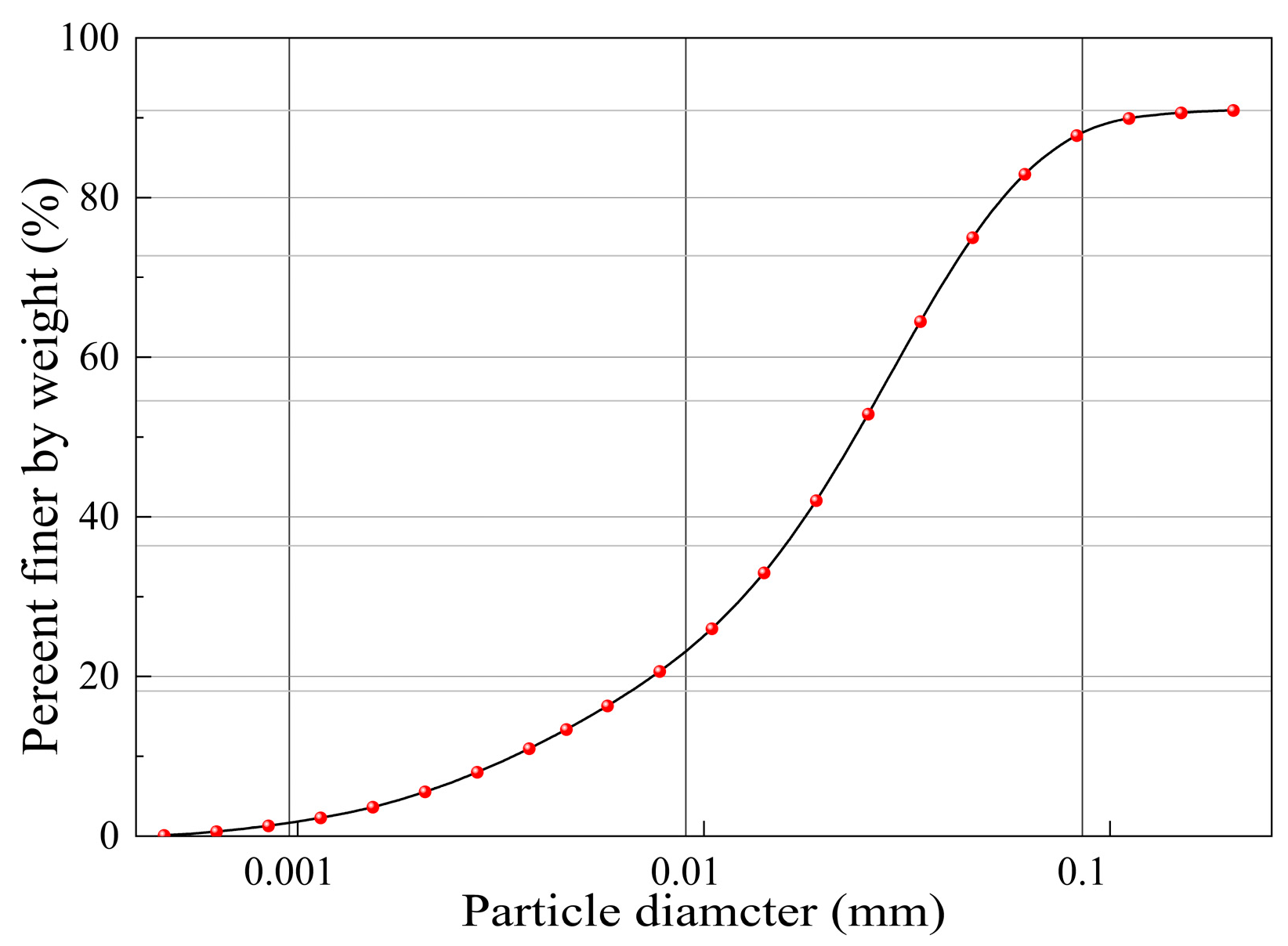
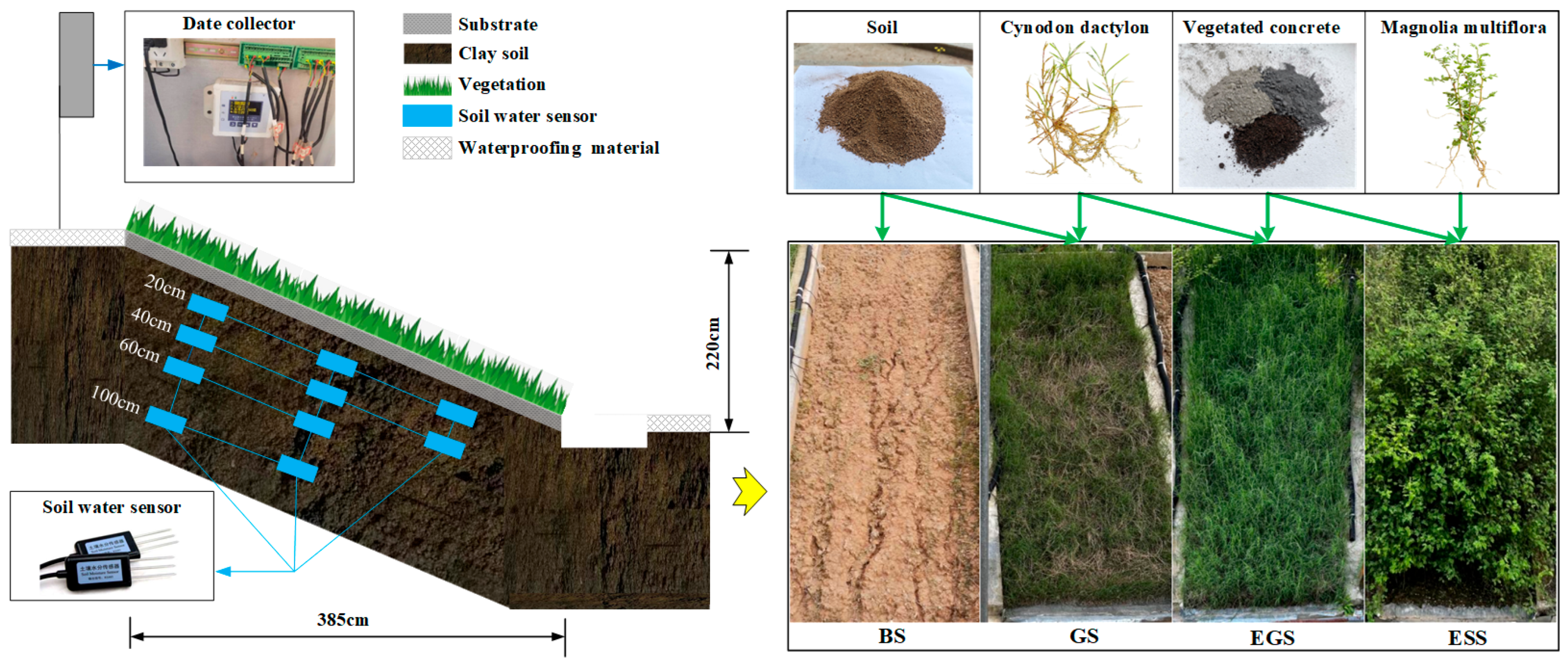
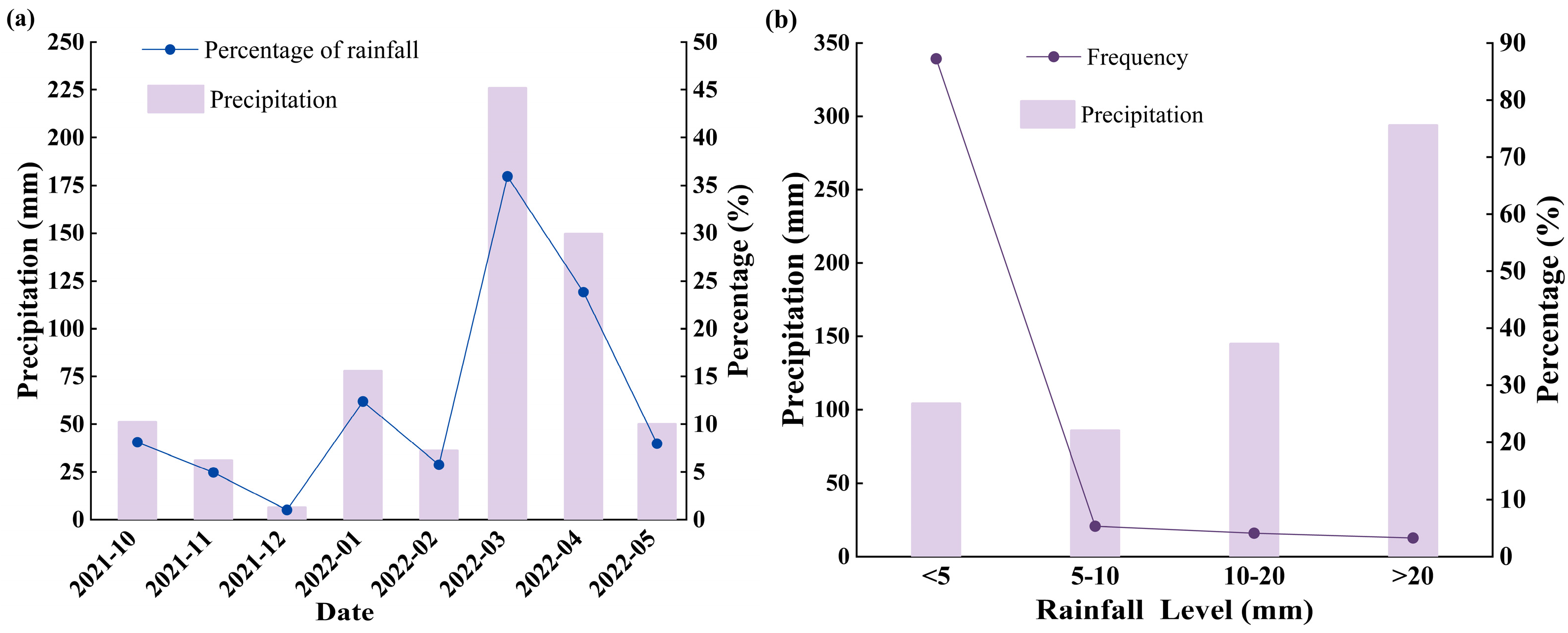

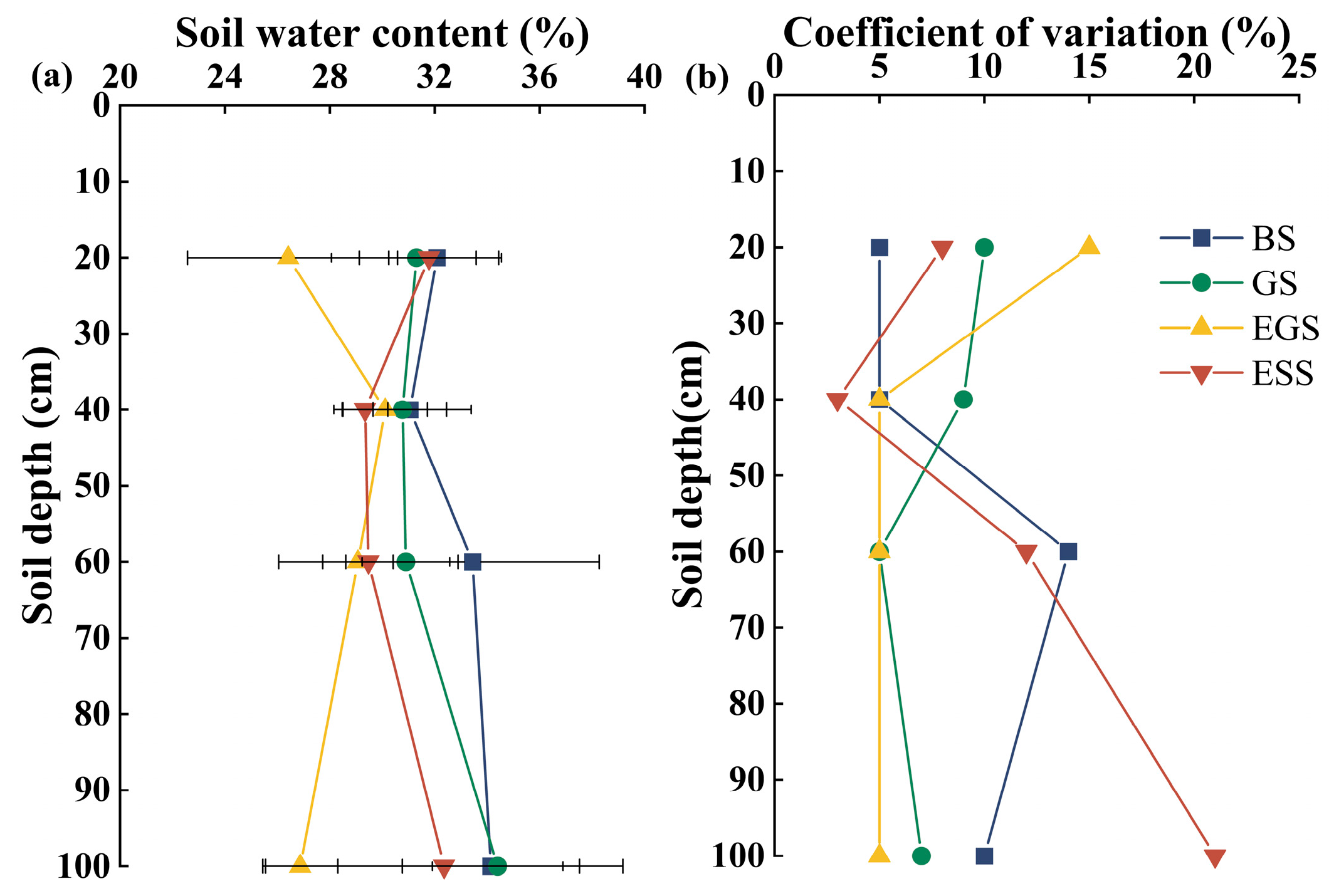

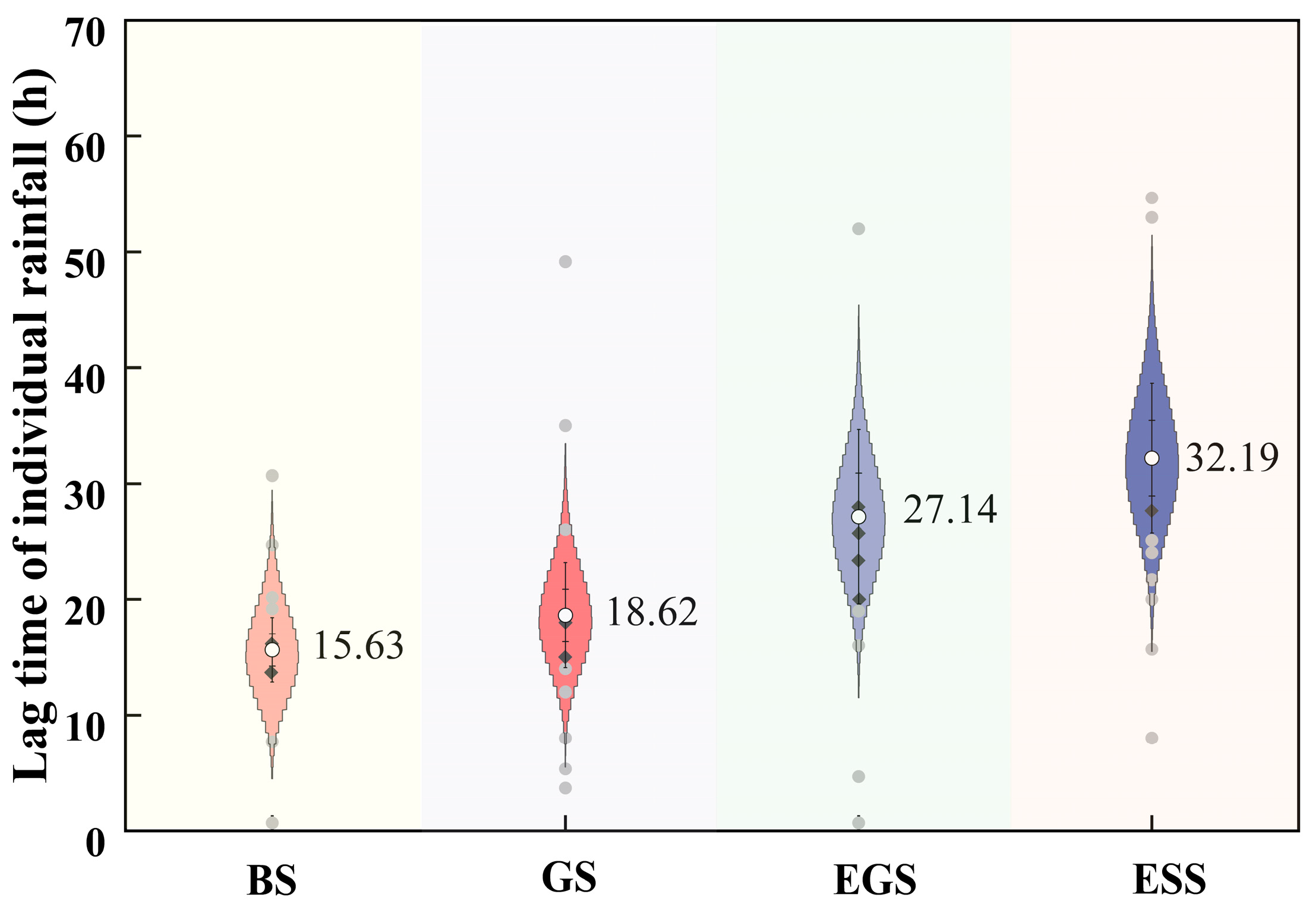
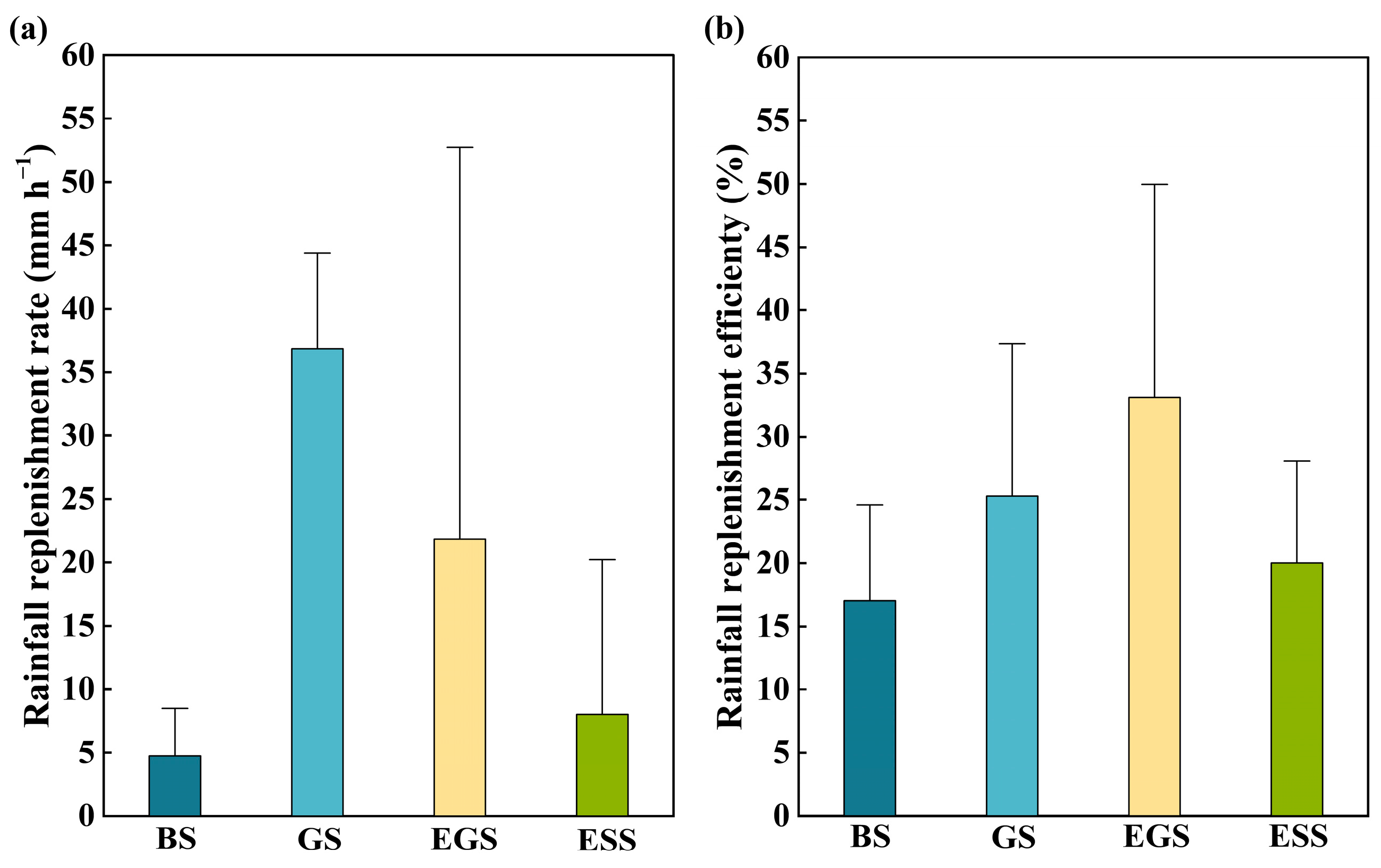

| Soil Parameters | Value |
|---|---|
| Initial volumetric water content (%) | 15.6 |
| Optimal volumetric water content (%) | 20 |
| Maximum dry density (g∙cm−3) | 1.750 |
| Natural dry density (g∙cm−3) | 1.5 |
| Plastic limit (%) | 23 |
| Liquid limit (%) | 41 |
| Soil PH value | 8.13 |
| Soil porosity (%) | 47.6 |
| Slope | Slope Ratio | Vegetated Concrete | Plant | Seeding Density | Plant Height |
|---|---|---|---|---|---|
| BS | 1:1.75 | - | - | - | - |
| GS | 1:1.75 | - | Cynodon dactylon | 30 g/m2 | 13~20 cm |
| EGS | 1:1.75 | 3 cm, 3% cement | Cynodon dactylon | 30 g/m2 | 15~28 cm |
| ESS | 1:1.75 | 3 cm, 3% cement | Magnolia multiflora | 30 g/m2 | 100~180 cm |
| CV | [0, 10%) | [10%, 100%) | [100%, +∞) |
|---|---|---|---|
| Variation level | Weak variation | Moderate variation | Strong variation |
| Slopes | Soil Depth | Max/% | Min/% | Mean/% | SD | CV/% |
|---|---|---|---|---|---|---|
| BS | 0~20 cm | 36.08 | 27.19 | 32.08 | 1.50 | 0.05 |
| 20~40 cm | 35.78 | 28.32 | 31.05 | 1.40 | 0.05 | |
| 40~60 cm | 40.57 | 27.13 | 33.44 | 4.83 | 0.14 | |
| 60~100 cm | 39.75 | 29.79 | 34.14 | 3.38 | 0.10 | |
| GS | 0~20 cm | 37.31 | 25.56 | 31.30 | 3.24 | 0.10 |
| 20~40 cm | 37.76 | 26.79 | 30.77 | 2.62 | 0.09 | |
| 40~60 cm | 34.53 | 24.39 | 30.09 | 1.67 | 0.05 | |
| 60~100 cm | 37.93 | 25.26 | 34.40 | 2.49 | 0.07 | |
| EGS | 0~20 cm | 36.72 | 21.60 | 26.41 | 3.84 | 0.15 |
| 20~40 cm | 36.46 | 27.00 | 30.11 | 1.61 | 0.05 | |
| 40~60 cm | 32.52 | 26.13 | 29.07 | 1.34 | 0.05 | |
| 60~100 cm | 31.79 | 17.75 | 26.87 | 1.43 | 0.05 | |
| ESS | 0~20 cm | 37.24 | 26.33 | 31.78 | 2.66 | 0.08 |
| 20~40 cm | 31.77 | 27.00 | 29.34 | 0.87 | 0.03 | |
| 40~60 cm | 34.80 | 25.20 | 29.47 | 3.42 | 0.12 | |
| 60~100 cm | 40.61 | 24.89 | 32.36 | 6.81 | 0.21 |
Disclaimer/Publisher’s Note: The statements, opinions and data contained in all publications are solely those of the individual author(s) and contributor(s) and not of MDPI and/or the editor(s). MDPI and/or the editor(s) disclaim responsibility for any injury to people or property resulting from any ideas, methods, instructions or products referred to in the content. |
© 2025 by the authors. Licensee MDPI, Basel, Switzerland. This article is an open access article distributed under the terms and conditions of the Creative Commons Attribution (CC BY) license (https://creativecommons.org/licenses/by/4.0/).
Share and Cite
Zhou, X.; Xia, F.; Xiao, H.; Ma, Q.; Zheng, L.; Shi, Y.; Lin, Z. Response Pattern of Rainfall to the Efficiency and Threshold of Soil Water Recharge in Different Slopes. Sustainability 2025, 17, 4018. https://doi.org/10.3390/su17094018
Zhou X, Xia F, Xiao H, Ma Q, Zheng L, Shi Y, Lin Z. Response Pattern of Rainfall to the Efficiency and Threshold of Soil Water Recharge in Different Slopes. Sustainability. 2025; 17(9):4018. https://doi.org/10.3390/su17094018
Chicago/Turabian StyleZhou, Xinlong, Fengwan Xia, Henglin Xiao, Qiang Ma, Lifei Zheng, Yunfeng Shi, and Zifeng Lin. 2025. "Response Pattern of Rainfall to the Efficiency and Threshold of Soil Water Recharge in Different Slopes" Sustainability 17, no. 9: 4018. https://doi.org/10.3390/su17094018
APA StyleZhou, X., Xia, F., Xiao, H., Ma, Q., Zheng, L., Shi, Y., & Lin, Z. (2025). Response Pattern of Rainfall to the Efficiency and Threshold of Soil Water Recharge in Different Slopes. Sustainability, 17(9), 4018. https://doi.org/10.3390/su17094018






